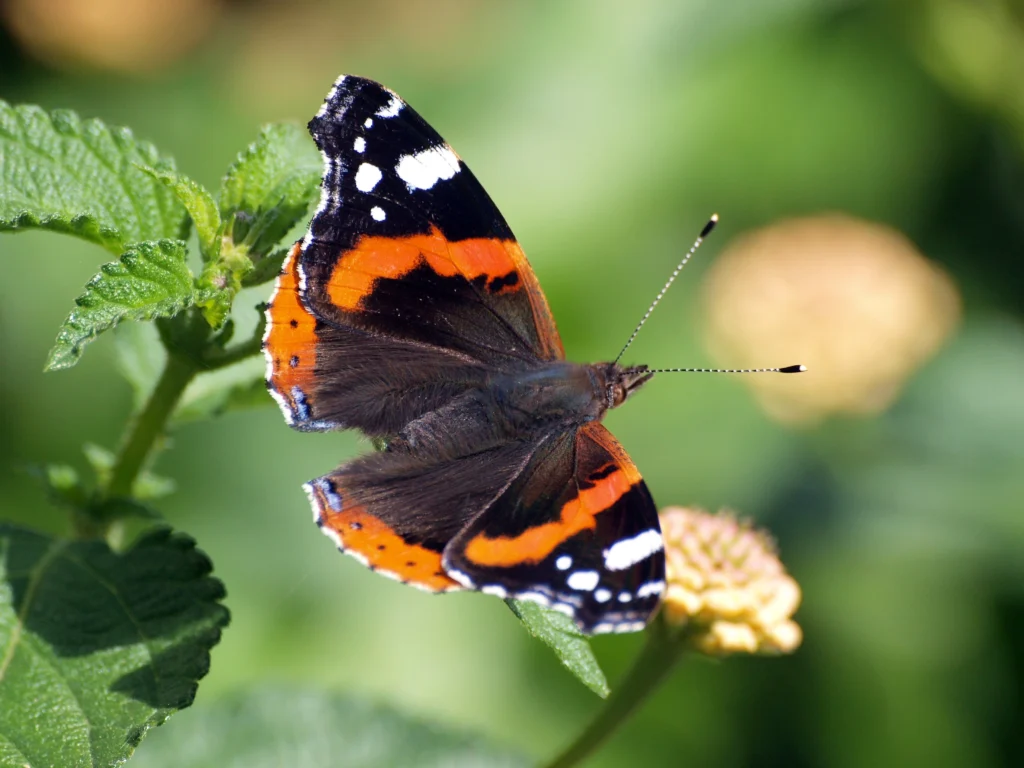“Butterflies are the ultimate symbol of transformation, showing us that even the most difficult times can lead to beautiful outcomes.” – Anonymous
The red admiral butterfly (Vanessa atalanta) is a striking and beautiful creature that captures the attention of nature enthusiasts and casual observers alike. Red Admiral Butterfly meaning and symbolisms are renowned because of its vivid orange-red bands against a dark backdrop on its wings, the red admiral holds significant meaning across various cultures.
Cultural and Spiritual Significance
“The butterfly’s flight is a testament to the power of persistence and perseverance.” – Anonymous
In many cultures, the red admiral butterfly symbolizes transformation, rebirth, and a connection to the divine, the transformation and rebirth part being the universal symbolism for butterflies. Its metamorphosis from caterpillar to butterfly is commonly seen as a metaphor for personal growth. Literature has also embraced the red admiral, with references in works like Nabokov’s “Speak, Memory” and “Pale Fire.” In popular culture, red admirals are the favored monogram in tattoos and spiritual symbols, representing the beauty and fragility of life. Different cultures interpret the sighting of a red admiral in various ways, ranging from good luck to messengers.
Taxonomy and Classification
“Butterflies remind us that the end of one journey is the beginning of another, more beautiful one.” – Anonymous
Vanessa atalanta, commonly known as the red admiral, belongs to the Nymphalidae family, which is one of the largest families of butterflies. Within the Systema Naturae, it is categorized under the genus Vanessa. This genus includes other notable species such as Vanessa cardui, the painted lady butterfly. The red admiral is closely related to other nymphalid butterflies, sharing many morphological and behavioral traits that make it a subject of interest for entomologists and lepidopterists.
Physical Characteristics
“Butterflies are the delicate dancers of the natural world, their wings a symphony of colors.” – Anonymous
The red admiral butterfly is easily identifiable because of its broad orange-red bands that traverse the forewings, contrasting sharply with the dark brown or black background. The hindwings are edged with blue spots that add to its appearance. With a wingspan ranging from 2 to 3 inches, the red admiral is of medium size compared to other butterflies. It possesses remarkable color vision, which plays a crucial role in its foraging and mating behaviors, allowing it to detect and discriminate between flowers and potential mates.
Habitat and Distribution
“The butterfly’s grace teaches us that beauty can be found in the simplest of things.” – Anonymous
The red admiral lives widely across Europe, North America, and parts of Asia and North Africa. It prefers a variety of habitats, including gardens, woodlands, meadows, and coastal areas, particularly nettle-rich environments. These butterflies are known for their migratory patterns, traveling considerable distances to find suitable habitats and breeding grounds. Their ability to adapt to different climates has allowed them to inhabit many regions, whether they be temperate zones or more arid landscapes.
Life Cycle and Behavior
“Butterflies are the fleeting moments of joy that life gives us, reminding us to appreciate the present.” – Anonymous
The life cycle of this butterfly (red admiral) has four stages: egg, larva (caterpillar), pupa (chrysalis), and adult (butterfly). Females lay their eggs on the leaves of host plants, such as stinging nettle (Urtica dioica) and false nettle (Boehmeria cylindrica). The larvae then feeds on these plants, undergoing several molts before pupating. As adults, red admirals feed on nectar from various flowers and overripe fruits. They start to exhibit territorial behavior, they are even seen defending their chosen perching sites from interlopers. During courtship, males perform complicated flight patterns to attract females. In colder climates, red admirals may hibernate as adults, seeking shelter in crevices or buildings.
Ecological Significance
“The butterfly’s transformation is nature’s way of showing us that we can all become something beautiful.” – Anonymous
Red admirals play an important role in pollination, contributing to the reproductive success of many flowering plants, especially those from the Compositae and Cannabaceae families. As bioindicators, they help scientists assess the health of ecosystems; changes in their populations results in change in environmental conditions. Their interactions with plants and other insects underscore their importance in maintaining ecological balance and biodiversity, it seems like nothing to the naked eye of us humans, but nature is vast and well maintained.
Adaptations and Resilience
“Butterflies are the living symbols of hope, love, and the beauty of small things.” – Anonymous
The red admiral butterflies demonstrate remarkable adaptability to different environmental conditions. It can tolerate a range of temperatures and habitats, which is an impressive feat and also crucial for its survival amid climate change. For instance, their flight patterns and the eye spots on their wings can confuse or deter potential threats.
Conservation Efforts
“The butterfly’s delicate flight is a metaphor for the lightness of being.” – Anonymous
The conservation status of the red admiral is generally stable, but habitat loss due to climate change and climate change itself pose significant threats. Conservation efforts focus on preserving natural habitats and host plants, like nettles, essential for their life cycle. Public awareness and participation are crucial for these efforts; initiatives like butterfly gardens and citizen science projects help monitor and support red admiral populations.
Fun Facts and Trivia
“Butterflies remind us to embrace change and trust the process of transformation.” – Anonymous
- Differences between males and females: Male red admirals are typically more territorial, while females are more selective in choosing their egg-laying sites.
- Comparison with white admiral butterflies: While both species share similar habitats, white admirals (Limenitis arthemis) have distinct black and white wing patterns.
- Unique behaviors: Red admirals are known for their migratory behavior, which can sometimes result in large, spectacular influxes in certain areas.
- Interactions with humans: These butterflies are often drawn to gardens and can be easily attracted by planting nectar-rich flowers.
Conclusion
The red admiral butterfly holds a special place in both nature and human culture. Its vibrant appearance, fascinating behaviors, and ecological roles make it a subject worthy of admiration and study.
“A butterfly’s journey is a gentle reminder of the beauty that comes from embracing change.” – Anonymous
References
- “The Butterflies of North America” by James A. Scott
- “Butterflies through Binoculars” by Jeffrey Glassberg
- Articles from the Journal of Lepidopterists’ Society
- Websites such as Butterfly Conservation and the National Wildlife Federation
- “Speak, Memory” and “Pale Fire” by Vladimir Nabokov

